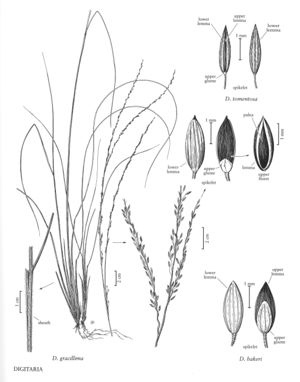Digitaria tomentosa
Plants perennial; cespitose, not rhizomatous. Culms 40-90 cm, erect, geniculate. Lower sheaths densely villous; upper sheaths with scattered papillose-based hairs; ligules 1.5-3 mm; blades 4-7 (12) cm long, 3-5 mm wide, villous to nearly glabrous, usually sparsely hairy near the ligules. Panicles simple, 10-18 cm, open; branches divergent; pedicels 0.4-3 mm, divergent, spikelets solitary. Spikelets 2-2.5 mm, elliptical, apiculate. Lower glumes absent or to 0.2 mm; upper glumes absent or to 0.6 mm, veinless; lower lemmas as long as the spikelets, 5-veined, margins and intercostal regions more or less pubescent; upper lemmas minutely rugose, dark-brown. 2n = 36.
Discussion
A native of southern India and Ceylon, Digitaria tomentosa is a noxious weed that is not known to occur in the Flora region. It is included here to help ensure that any introduction is correctly identified.
Selected References
None.
Lower Taxa
"decumbent" is not a number.
